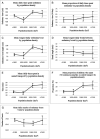Levels and Correlates of Objectively Measured Sedentary Behavior in Young Children: SUNRISE Study Results from 19 Countries
- PMID: 35142711
- PMCID: PMC9203875
- DOI: 10.1249/MSS.0000000000002886
Levels and Correlates of Objectively Measured Sedentary Behavior in Young Children: SUNRISE Study Results from 19 Countries
Abstract
Purpose: There is a paucity of global data on sedentary behavior during early childhood. The purpose of this study was to examine how device-measured sedentary behavior in young children differed across geographically, economically, and sociodemographically diverse populations, in an international sample.
Methods: This multinational, cross-sectional study included data from 1071 children 3-5 yr old from 19 countries, collected between 2018 and 2020 (pre-COVID). Sedentary behavior was measured for three consecutive days using activPAL accelerometers. Sedentary time, sedentary fragmentation, and seated transport duration were calculated. Linear mixed models were used to examine the differences in sedentary behavior variables between sex, country-level income groups, urban/rural settings, and population density.
Results: Children spent 56% (7.4 h) of their waking time sedentary. The longest average bout duration was 81.1 ± 45.4 min, and an average of 61.1 ± 50.1 min·d-1 was spent in seated transport. Children from upper-middle-income and high-income countries spent a greater proportion of the day sedentary, accrued more sedentary bouts, had shorter breaks between sedentary bouts, and spent significantly more time in seated transport, compared with children from low-income and lower-middle-income countries. Sex and urban/rural residential setting were not associated with any outcomes. Higher population density was associated with several higher sedentary behavior measures.
Conclusions: These data advance our understanding of young children's sedentary behavior patterns globally. Country income levels and population density appear to be stronger drivers of the observed differences, than sex or rural/urban residential setting.
Copyright © 2022 The Author(s). Published by Wolters Kluwer Health, Inc. on behalf of the American College of Sports Medicine.
Figures
References
-
- Cliff DP Hesketh KD Vella SA, et al. . Objectively measured sedentary behaviour and health and development in children and adolescents: systematic review and meta-analysis. Obes Rev. 2016;17(4):330–44. - PubMed
-
- Jones RA, Hinkley T, Okely AD, Salmon J. Tracking physical activity and sedentary behavior in childhood: a systematic review. Am J Prev Med. 2013;44(6):651–8. - PubMed


